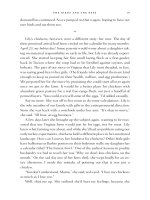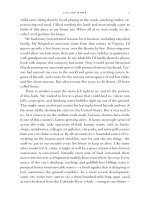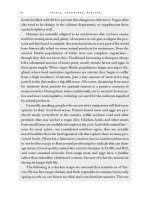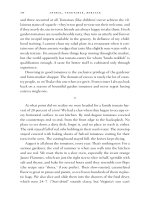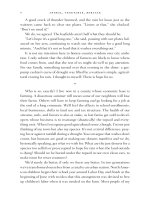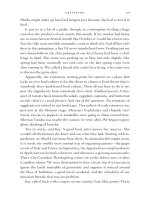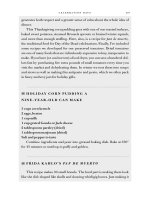Animal, vegetable, miracle a year of food life phần 21
Bạn đang xem bản rút gọn của tài liệu. Xem và tải ngay bản đầy đủ của tài liệu tại đây (61.26 KB, 5 trang )
the birds and the bees
93
demand has continued. So we jumped on that wagon, hoping to have our
rare birds and eat them too.
/
Lily’s chickens, however, were a different story: her own. The day of
their promised arrival had been circled on her calendar for many months:
April 23, my babies due! Some parents would worry about a daughter taking on maternal responsibility so early in life, but Lily was already experienced. She started keeping her first small laying flock as a first-grader,
back in Tucson where the coop had to be fortified against coyotes and
bobcats. The part of our move to Virginia that Lily most dreaded, in fact,
was saying good-bye to her girls. (The friends who adopted them are kind
enough to keep us posted on their health, welfare, and egg production.)
We prepared her for the move by promising she could start all over again
once we got to the farm. It would be a better place for chickens with
abundant green pasture for a real free-range flock, not just a handful of
penned layers. “You could even sell some of the eggs,” I’d added casually.
Say no more. She was off to her room to do some calculations. Lily is
the sole member of our family with gifts in the entrepreneurial direction.
Soon she was back with a notebook under her arm. “It’s okay to move,”
she said. “I’ll have an egg business.”
A few days later she brought up the subject again, wanting to be reassured that our Virginia hens would just be for eggs, not for meat. Lily
knew what farming was about, and while she’d had no problem eating our
early turkey experiments, chickens held a different place in her emotional
landscape. How can I convey her fondness for chickens? Other little girls
have ballerinas or Barbie posters on their bedroom walls; my daughter has
a calendar titled “The Fairest Fowl.” One of the earliest lessons in poultry
husbandry we had to teach her was “Why we don’t kiss chickens on the
mouth.” On the sad day one of her hens died, she wept loudly for an entire afternoon. I made the mistake of pointing out that it was just a
chicken.
“You don’t understand, Mama,” she said, red-eyed. “I love my chickens
as much as I love you.”
Well, shut me up. She realized she’d hurt my feelings, because she
94
a n i m a l , v e g e ta b l e , m i r ac l e
crept out of her room an hour later to revise the evaluation. “I didn’t really
mean that, Mama,” she sniffled. “I’m sorry. If I love my chickens six, I love
you seven.”
Oh, good. I’m not asking who’s a ten.
So I knew, in our discussions of poultry commerce, I needed to be reassuring. “They’ll be your chickens,” I told her. “You’re the boss. What you
sell is your decision.”
As weeks passed and her future on the farm began to take shape in her
mind, Lily asked if she’d also be able to have a horse. Her interest in
equines surpasses the standard little-girl passion of collecting plastic ones
with purple manes and tail; she’d lobbied for riding lessons before she
could ride a bike. I’d long assumed a horse was on our horizon. I just
hoped it could wait until Lily was tall enough to saddle it herself.
In the time-honored tradition of parents, I stalled. “With your egg
business, you can raise money for a horse yourself,” I told her. “I’ll even
match your funds—we’ll get a horse when you have half the money to
buy one.”
When I was a kid, I would have accepted these incalculable vagaries
without a second thought, understanding that maybe a horse was out
there for me but I’d just have to wait and see. The entrepreneurial gene
apparently skips generations. Lily got out her notebook and started asking
questions.
“How much does a horse cost?”
“Oh, it depends,” I hedged.
“Just a regular mare, or a gelding,” she insisted. When it comes to
mares and geldings, she knows the score. I’d recently overheard her explaining this to some of her friends. “A stallion is a boy that’s really fierce
and bossy,” she told them. “But they can give them an operation that
makes them gentle and nice and helpful. You know. Like our daddies.”
Okay, then, this girl knew what she was looking for in horseflesh. What
does an animal like that cost, she inquired? “Oh, about a thousand dollars,” I said, wildly overestimating, pretty sure this huge number would
end the conversation.
Her eyes grew round.
“Yep,” I said. “You’ll have to earn half. Five hundred.”
the birds and the bees
95
She eyed me for a minute. “How much can I sell a dozen eggs for?”
“Nice brown organic eggs? Probably two-fifty a dozen. But remember,
you have to pay for feed. Your profit might be about a dollar a dozen.”
She disappeared into her room with the notebook. She was only a
second-grader then, as yet unacquainted with long division. I could only
assume she was counting off dollar bills on the calendar to get to five hundred. In a while she popped out with another question.
“How much can you sell chicken meat for?”
“Oh,” I said, trying to strike a morally neutral tone in my role as financial adviser, “organic chicken sells for a good bit. Maybe three dollars a
pound. A good-size roasting bird might net you ten dollars, after you subtract your feed costs.”
She vanished again, for a very long time. I could almost hear the spiritual wrestling match, poultry vs. equines, fur and feathers flying. Many
hours later, at dinner, she announced: “Eggs and meat. We’ll only kill the
mean ones.”
/
I know I’m not the first mother to make an idle promise I’d come to
regret. My mother-in-law has told me that Steven, at age seven, dashed
through her kitchen and shouted on the way through, “Mom, if I win a
monkey in a contest, can I keep it?” Oh, sure honey, Joann said, stirring
the pasta. She had seven children and, I can only imagine, learned to tune
out a lot of noise. But Steven won the monkey. And yes, they kept it.
In my case, what I’d posed as a stalling tactic turned out to be a powerful nudge, moving Lily from the state of loving something as much as her
mother (or six-sevenths as much) to a less sentimental position, to put it
mildly. I watched with interest as she processed and stuck to her choices.
I really had no idea where this would end.
Chicks must be started no later than April if they’re to start laying before cold weather. We moved to the farm in June, too late. From friends
we acquired a few mature hens to keep us in eggs, and satisfy Lily’s minimum daily requirement of chicken love. But the farm-fresh egg business
had to wait. Finally, toward the end of our first winter here, we’d gotten
out the hatchery catalog and curled up on the couch to talk about a spring
96
a n i m a l , v e g e ta b l e , m i r ac l e
poultry order. Lily shivered with excitement as we discussed the pros and
cons of countless different varieties. As seed catalogs are to me, so are the
hatchery catalogs for my daughter. Better than emeralds and diamonds,
these Rocks, Wyandottes, and Orpingtons. She turned the pages in a
trance.
“First of all, some Araucanas,” she decided. “Because they lay pretty
green eggs. My customers will like those.”
I agreed, impressed with her instincts for customer service.
“And for the main laying flock I want about ten hens,” she said. “We’ll
keep one of the roosters so we can have chicks the next spring.”
She read listings for the heavy breeds, studying which ones were strong
winter layers, which were good mothers (some breeds have motherhood
entirely bred out of them and won’t deign to sit on their own eggs). She
settled on a distinguished red-and-black breed called Partridge Rocks.
We ordered sixteen of these, straight run (unsexed), of which about half
would grow up to be females. Lily knows you can’t have too many roosters
in a flock—she had mentioned we would “keep” one of the males, implying the rest would be dispatched. I didn’t comment. But it seemed we
were now about seven roosters closer to a horse. I hoped they would all be
very, very mean.
She paused over a section of the catalog titled “Broilers, Roasters and
Fryers.”
“Look at these,” she said, showing me a picture of an athletic-looking
fowl, all breast and drumstick. “Compact bodies and broad, deep
breasts . . . ,” she read aloud. “These super meat qualities have made the
Dark Cornish a truly gourmet item.”
“You’re sure you want to raise meat birds too?” I asked. “Only if you
want to, honey.” I was starting to crumble. “You’ll get your horse someday,
no matter what.”
“It’s okay,” she said. “I won’t name them. I’ll have my old pet hens to
love.”
“Of course,” I said. “Pets are pets. Food is food.”
Out on the near horizon, Lily’s future horse pawed the ground and
whinnied.
Eating My Sister’s Chickens
by camille
/
During my first year of college, one of my frequent conversations went like
this:
“Camille, you’re a vegetarian, right?”
“Well, no.”
“No? You really seem like the type.”
“Well, I only eat free-range meat.”
“Free who?”
I guess I do seem like the type. Personal health and the environment are
important to me, and my vocational path even hints at vegetarianism—I
teach yoga, and may study nutrition in graduate school. The meat-eating
question is one I’ve considered from a lot of angles, but that’s not easy to
explain in thirty seconds. A lunch line is probably not the best place to do
it, either. For one thing, all meat is not created equal. Cows and chickens
that spent their lives in feedlots, fattening up on foods they did not evolve
to eat, plus antibiotics, produce different meat from their counterparts that
lived outdoors in fresh air, eating grass. That’s one nutritional consideration to bear in mind while weighing the pros and cons of vegetarianism.
There are others, too. Vegetarians and vegans should consider taking
iron supplements because the amount of this nutrient found in plant
sources is minuscule compared with the amount found in meat. Of course,
eating plenty of iron-containing dark leafy greens, legumes, and whole
grains is a good plan. Along with a host of other essential nutrients, they do
offer a good bit of iron, but in some cases it may not be enough to keep the
body producing hemoglobin. Vitamin B12 is also tricky; in its natural form
it’s found only in animal products. There are traces of it in fermented soy
and seaweed, but the Vegetarian Society warns that the form of B12 in plant
sources is likely unavailable to human digestion. This means that vegans—
people who eat no meat, dairy, or eggs—need to rely on supplements or


